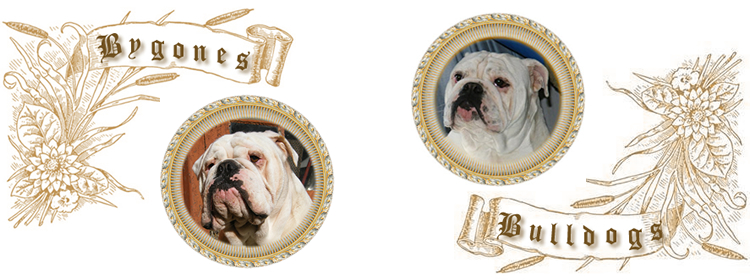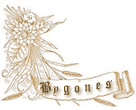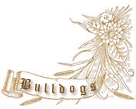
 |
| A Breed Standard is the guideline which describes the ideal characteristics, temperament and appearance of a breed and ensures that the breed is fit for function. Absolute soundness is essential. Breeders and judges should at all times be careful to avoid obvious conditions or exaggerations which would be detrimental in any way to the health, welfare or soundness of this breed. From time to time certain conditions or exaggerations may be considered to have the potential to affect dogs in some breeds adversely, and judges and breeders are requested to refer to the Kennel Club website for details of any such current issues. If a feature or quality is desirable it should only be present in the right measure. |
Key to Gaia Research Indications
in the Final Revised U.K. Kennel Club Bulldog Breed Standard |
 |
 |
| General Appearance (changed) | ||
| Smooth-coated, fairly thick set, rather low in stature, broad, powerful and compact. Head, fairly large in proportion to size but no point so much in excess of others as to destroy the general symmetry, or make the dog appear deformed, or interfere with its powers of motion. Face relatively short, muzzle broad, blunt and inclined upwards although not excessively so. Dogs showing respiratory distress highly undesirable. Body fairly short, well knit, limbs stout, well muscled and in hard condition with no tendency towards obesity. Hindquarters high and strong, [but somewhat lighter in comparison with heavy foreparts]. Bitches not so grand or well developed as dogs. | ||
| Characteristics
(unchanged) |
||
| Conveys impression of determination, strength
and activity. |
||
 |
||
| Temperament (unchanged) | ||
| Alert, bold, loyal, dependable, courageous, fierce in appearance, but possessed of affectionate nature. | ||
|
|
||
 |
||
| Head and Skull (changed) | ||
| Skull relatively large in circumference. Viewed from front appears high from corner of lower jaw to apex of skull; also [very] broad and square. Cheeks well rounded and extended sideways beyond eyes. Viewed from side, head appears very high and moderately short from back to point of nose. Forehead flat with skin on and about head slightly loose and (may be) finely wrinkled without excess, neither prominent nor overhanging face. [Projections of frontal bones prominent, broad, square and high; deep, wide indentation between eyes.] From defined stop, a furrow [both broad and deep] extending to middle of skull being traceable to apex.
Face from front of cheek bone to nose, relatively short, skin may be slightly wrinkled. Muzzle short, broad, turned upwards and (very) deep from corner of eye to corner of mouth. Nose and nostrils large, broad and black, under no circumstances liver colour, red or brown. Distance from inner corner of eye (or from centre of stop between eyes) to extreme tip of nose should not be less than distance from tip of the nose to edge of the underlip. Nostrils large wide and open, with well defined vertical straight line between. Flews (chops) thick, broad [pendant] and [very] deep, [hanging completely over,] covering lower jaws at sides, but joining underlip in front [and quite covering the teeth].
Teeth not visible. Jaws
broad, [massive,] strong
and square, lower jaw slightly projecting in front of upper with
moderate [and] turn[ing] up. Over
nose [roll] wrinkle,
if present, whole or broken, must [not interfere with
the line of the layback]
never adversely affect or obscure eyes or nose. Pinched nostrils
and heavy over nose roll are unacceptable and should be heavily
penalised. Viewed from front, the various properties of the
face must be equally balanced on either side of an imaginary line
down centre. |
||
 |
||
| Eyes (unchanged) | ||
| Seen from
front, situated low down in skull, well away from ears. Eyes and
stop in same straight line, at right angles to furrow. Wide apart,
but outer corners within the outline of cheeks. Round, of moderate
size, neither sunken nor prominent, in colour very dark –
almost black – showing no white when looking directly forward.
Free from obvious eye problems. |
||
 |
||
| Ears (unchanged) | ||
| Set high – i.e. front edge of each ear (as viewed from front) joins outline of skull at top corner of such outline, so as to place them as wide apart, as high and as far from eyes as possible. Small and thin. ’Rose ear‘ correct, i.e. folding inwards back, upper or front inner edge curving outwards and backwards, showing part of inside of burr. | ||
 |
||
|
|
||
| Mouth (unchanged) | ||
| Jaws broad and square with six small front teeth between canines in an even row. Canines wide apart. Teeth large and strong, not seen when mouth closed. When viewed from front under jaw directly under upper jaw and parallel. | ||
 |
||
|
|
||
| Neck (changed) | ||
| Moderate in length, [very] thick, deep and strong. Well arched at back, with [much] some loose, thick and wrinkled skin about throat, forming slight dewlap on each side from lower jaw to chest. | ||
 |
||
|
|
||
| Forequarters (changed) | ||
| Shoulders broad, sloping and deep, very powerful and muscular giving appearance of being ‘tacked on’ body. Brisket [capacious] round and [very] deep [from top of shoulders to lowest part where it joins chest]. Well let down between forelegs. Ribs [large in diameter,] not flat-sided, but well rounded. Forelegs very stout and strong, well developed, set wide apart, thick, muscular and straight, [presenting rather bowed outline but] bones of legs large and straight, not bandy nor curved and short in proportion to hindlegs, but not so short as to make back appear long, or detract from dog’s activity [and so cripple him]. Elbows low and standing well away from ribs. Pasterns short, straight and strong. | ||
 |
||
|
|
||
| Body (changed) | ||
| Chest wide, [laterally round]
prominent and deep. Back short, strong, broad at shoulders. Slight
fall to back close behind shoulders (lowest part) whence spine should
rise to loins (top higher than top of shoulder), curving again more
suddenly to tail, forming slight arch [(termed roach back)]
– a distinctive characteristic of breed. Body well ribbed
up behind with belly tucked up and not pendulous." |
||
 |
||
| Hindquarters (changed) | ||
| Legs large and muscular, slightly longer in proportion than forelegs [so as to elevate loins]. Hocks slightly bent, well let down; legs long and muscular from loins to hock [short, straight, strong lower part]. Stifles [round and] turned very slightly outwards away from body. [Hocks thereby made to approach each other and hind feet to turn outwards]. | ||
 |
||
| Feet (unchanged) | ||
| Fore, straight and turning very slightly outward; of medium size and moderately round. Hind, round and compact. Toes compact and thick, well split up, making knuckles prominent and high. | ||
 |
||
| Tail (unchanged) | ||
| Set on low, jutting out rather
straight and then turning downwards. Round, smooth and devoid of
fringe or coarse hair. Moderate in length – rather short than
long – thick at root, tapering quickly to a fine point. Downward
carriage (not having a decided upward curve at end) and never carried
above back. |
||
 |
||
| Gait/Movement (changed) | ||
| [Peculiarly heavy and constrained,] Appearing to walk with short, quick steps on tips of toes, hind feet not lifted high, appearing to skim ground, running with one or other shoulder rather advanced. Soundness of movement of the utmost importance. | ||
 |
||
| Coat (unchanged) | ||
| Fine texture, short, close and smooth (hard only from shortness and closeness, not wiry). | ||
 |
||
| Colour (unchanged) | ||
| Whole or smut, (i.e. whole colour with black mask or muzzle). Only whole colours (which should be brilliant and pure of their sort) viz., brindles, reds with their various shades, fawns, fallows etc., white and pied (i.e. combination of white with any of the foregoing colours). Dudley, black and black with tan highly undesirable. | ||
 |
||
|
|
||
| Size (unchanged) | ||
| Dogs: 25 kgs (55 lbs); bitches: 23 kgs (50 lbs). | ||
 |
||
| Faults (unchanged) | ||
| Any departure from the foregoing points should be considered a fault and the seriousness with which the fault should be regarded should be in exact proportion to its degree and its effect upon the health and welfare of the dog. | ||
Click
here to proceed to the Perfect
Bulldog page. |
||
 |
Bygones Bulldogs is copyright © 2009. Bygones Bulldogs all rights reserved |
 |

